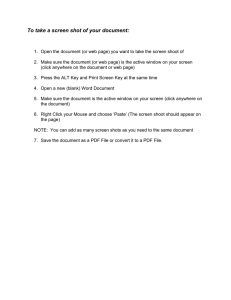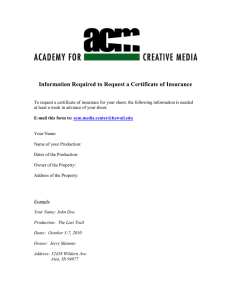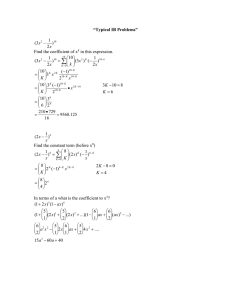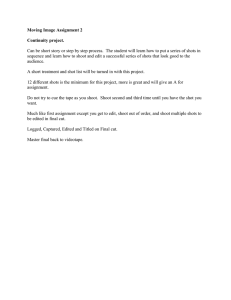A methodology for recovering cassava plants from shoot tips
advertisement
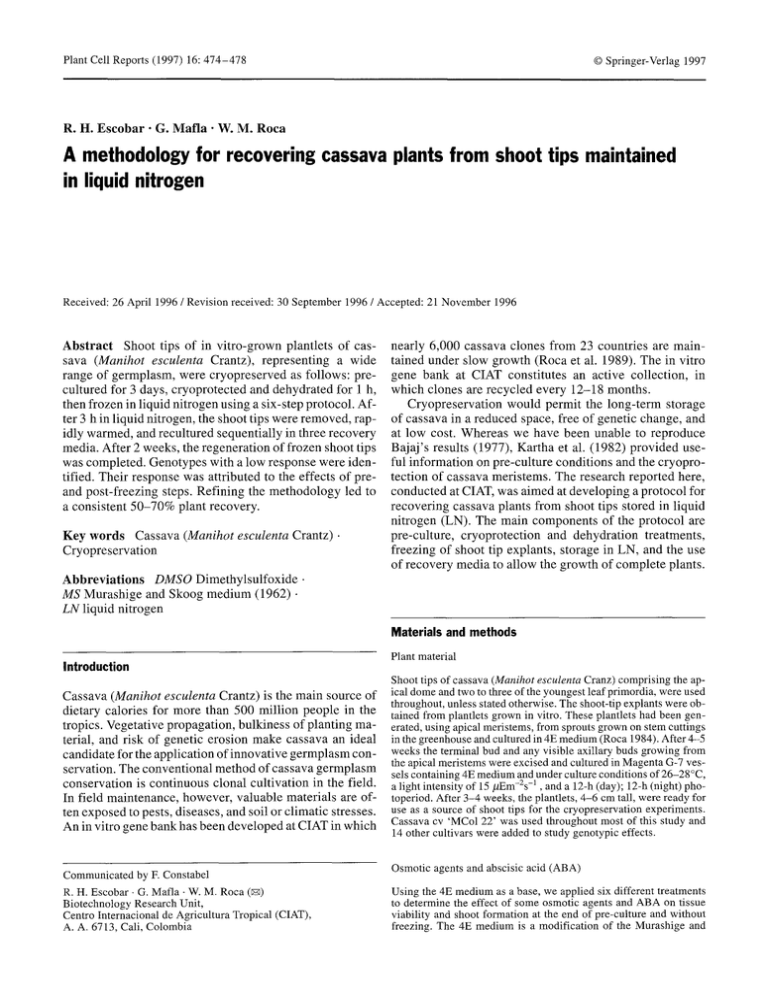
Plant Cell Reports (1997) 16:474-478
R. H. Escobar
• G. Mafia
© Springer-Verlag 1997
• W. M. Roca
A methodology for recovering cassava plants from shoot tips maintained
in liquid nitrogen
Received: 26 April 1996 / Revision received: 30 September 1996 / Accepted: 21 November 1996
Abstract
Shoot tips of in vitro-grown plantlets of c a s s a v a (Manihot esculenta Crantz), representing a wide
range of germplasm, were cryopreserved as follows: precultured for 3 days, cryoprotected and dehydrated for 1 h,
then frozen in liquid nitrogen using a six-step protocol. After 3 h in liquid nitrogen, the shoot tips were removed, rapidly warmed, and recultured sequentially in three recovery
media. After 2 weeks, the regeneration of frozen shoot tips
w a s completed. Genotypes with a low response were identified. Their response was attributed to the effects of preand post-fi'eezing steps. Refining the m e t h o d o l o g y led to
a consistent 5 0 - 7 0 % plant recovery.
Cassava (Manihot esculenta Crantz) •
Cryopreservation
Key words
nearly 6,000 cassava clones from 23 countries are maintained under slow growth (Roca et al. 1989). The in vitro
gene bank at CIAT constitutes an active collection, in
which clones are recycled every 12-18 months.
Cryopreservation would permit the long-term storage
of cassava in a reduced space, free of genetic change, and
at low cost. Whereas we have been unable to reproduce
Bajaj's results (1977), Kartha et al. (1982) provided useful information on pre-culture conditions and the cryoprotection of cassava meristems. The research reported here,
conducted at CIAT, was aimed at developing a protocol for
recovering cassava plants from shoot tips stored in liquid
nitrogen (LN). The main components of the protocol are
pre-culture, cryoprotection and dehydration treatments,
freezing of shoot tip explants, storage in LN, and the use
of recovery media to allow the growth o f complete plants.
Abbreviations
DMSO Dimethylsulfoxide •
MS Murashige and Skoog medium (1962) •
LN liquid nitrogen
Materials and methods
introduction
Cassava (Manihot escuIenta Crantz) is the main source of
dietary calories for more than 500 million people in the
tropics. Vegetative propagation, bulkiness of planting material, and risk of genetic erosion make cassava an ideal
candidate for the application of innovative germplasm conservation. The conventional method of cassava germplasm
conservation is continuous clonal cultivation in the field.
In field maintenance, however, valuable materials are often exposed to pests, diseases, and soil or climatic stresses.
An in vitro gene bank has been developed at CIAT in which
Communicated by F. Constabel
R. H. Escobar. G. Mafia - W. M. Roca ([])
Biotechnology Research Unit,
Centro Internacional de Agricultura Tropical (CIAT),
A. A. 6713, Cali, Colombia
Plant material
Shoot tips of cassava (Manihot esculenta Cranz) comprising the apical dome and two to three of the youngest leaf pril-nordia, were used
throughout, unless stated otherwise. The shoot-tip explants were obtained from plantlets grown in vitro. These plantlets had been generated, using apical meristems, from sprouts grown on stem cuttings
in the greenhouse and cultured in 4E medium (Roca 1984). After 4-5
weeks the terminal bud and any visible axillary buds growing from
the apical meristems were excised and cultured in Magenta G-7 vessels containing 4E medium and under culture conditions of 26-28 °C,
a light intensity of 15 #Em-Zs -1 , and a 12-h (day); 12-h (night) photoperiod. After 3-4 weeks, the plantlets, 4-6 cm tall, were ready for
use as a source of shoot tips for the cryopreservation experiments.
Cassava cv 'MCol 22' was used throughout most of this study and
14 other cultivars were added to study genotypic effects.
Osmotic agents and abscisic acid (ABA)
Using the 4E medium as a base, we applied six different treatments
to determine the effect of some osmotic agents and ABA on tissue
viability and shoot formation at the end of pre-culture and without
freezing. The 4E medium is a modification of the Murashige and
475
Skoog medium (1962) developed by Roca (1984) and contains
1.7x10 -7 M 6-benzylamino purine (BAP), 1.44x10 7 M gibberellic
acid (GA), 1.07x 10.7 M 1-naphthaleneacetic acid (NAA), 2.96× 10.6
M thiamine-HC1, 5.55×10 -4 M inositol, and 0.7% agar, pH 5.7-5.8.
When ABA was used in the medium, BAP was omitted. The treatments were:
1) 4E medium, supplemented with 0.25, 0.5, 0.75, and 1 M sorbitol
over a period of 7, 10, 15, and 20 days each
2) 4E medium, supplemented with 1.5, 2.5, 3.5, and 5 M sorbitol for
1, 3, 5, and 7 days each
3) 4E medium, supplemented with 1 M sorbitol and 0.25, 0.5, 0.75,
and 1 M sucrose for 1, 3, 5, and 7 days each
4) 4E medium, supplemented with 1 M sorbitol and 0.001, 0.01, 0.1,
and 1 M dimethylsulfoxide (DMSO) for 1, 3, 5, and 7 days each
5) 4E medium supplemented with 10 3, 10-5, 10-7, and 10-10 M ABA
for 1, 3, 5, and 7 days each
6) 4E medium, supplemented with 1 M sorbitol and 10 3, 10-s, 10-7,
and 10-l° M ABA for 1, 3, 5, and 7 days each
A total of 2 600 shoot tips of cv 'MCo122' were used for this experiment. Of these, 200 explants were kept throughout the trials in 4E
medium without supplements as control. Each treatment consisted
of 400 shoot tips, thus 25 shoot tips were used per each individual
sub-treatment. Cultures were maintained at 26°-28°C, a light intensity of 15//Em-2s -land a 12 h/day photoperiod. Explants were placed
in petri dishes since this experiment did not involve freezing. At the
end of each treatment, 15 shoot tips were taken at random and transferred to 4E medium for regrowth. Two parameters were measured:
viability (survival of tissues growing in any form; e.g., callus with
or without shoot primordia) and shoot growth (regrown tissue with
plantlet recovery) after 4 weeks.
Shoot-tip size
Shoot-tip explants were either small (1-2 mm in height) or large (3-4
mm in height). A total of 110 explants were used per treatment. Shoottips were precultured in C4 medium (MS salts with 1 M sorbitol,
0.1 M DMSO, and 4% sucrose) at 26°-28°C in the dark, before cryoprotection. Cryoprotection was carried out in 10% DMSO and 1 M
sorbitol for 2 h on ice. After cryoprotection, the cryoprotectants were
removed and the shoot tips were dehydrated for 1 h on Whatman No.
2 filter paper placed inside the petri dishes. Shoot tips were dried at
room temperature (24°-26°C) and on ice; 10 shoot tips were used
per temperature treatment and transferred to ampoules for freezing.
The freezing protocol used in this experiment was 0.5°C per minute
to -15°C, with rapid changes between -15°C and -17°C, then I°C
per minute to -40°C. After freezing to -40°C, the explants were immersed directly in LN for 3 h. Frozen explants were thawed at 37°C
and then recovered sequentially in two media for 2 days each, R1
(0.75 M sucrose with 0.2% activated charcoal) and R2 (half-strength
MS with 0.35 M sucrose and 5.56x10 -3 M inositol), at 25°c in the
dark. The explants were then transferred to a third semisolid medium (4E) at 28°C and under a light intensity of 15 #Em2s ~.
Genotypic response
Fourteen cassava varieties from the in vitro collection maintained at
CIAT were randomly selected for use in this experiment: 'MArg 2',
'MBra 161', 'MCol 1468', 'MCR 113', 'MCub 27', 'MDom 2',
'MEcu 48', 'MGua 14', 'MMex 71 ', 'MPan 125', 'MPar 193', 'MPer
303', 'MVen 232', and 'CM 922-2'. 'MCol 22' was used as control.
The number of shoot tips per cassava variety varied from 86 to 120.
The cryopreservation protocol applied to material in this part of
the work included the best conditions with respect to explant size,
pre-culture medium, tissue dehydration, and recovery media, which
were obtained fom the earlier parts of this study.
1) Explant: shoot tips (2 mm in height);
2) Pre-culture: C4 medium for 3 days in the dark at 26°-28°C;
3) Cryoprotection with: 1 M sorbitol, 10% DMSO, and 4% sucrose
for 2 h on ice;
4) Tissue dehydration: on filter paper for 1 h;
5) Freezing with a Cryomed 1010 machine: (1) 5°C wait chamber,
(2) 0.5°C per minute until -15°C in sample, (3) 25°C to -20°C in
chamber, (4) 15°C to -17°C in chamber, (5) I°C per minute to -40°C
in sample;
6) Immersion and storage in liquid nitrogen;
7) Thawing at 37°C;
8) Recovery: R1 medium followed by R2 medium for 2 days each,
then transferred to semisolid 4E medium; and
9) Evaluation: tissue viability and shoot growth after 1 month.
Ten explants from each variety were placed on 4E medium in petri
dishes and kept, as control under the conditions described above.
Results and discussion
Effect of o s m o t i c agents and A B A
This part of the w o r k was a i m e d at o b s e r v i n g the effect o f
m e d i a c o m p o n e n t s on tissue r e g r o w t h at the end of preculture, without freezing. Table 1 shows the overall effect
o f treatments on tissue v i a b i l i t y and shoot growth, and Table 2 c o m p a r e s the effects of i n d i v i d u a l sub-treatments on
shoot growth over time. A nested statistical analysis was
used to assess the overall effect of the six treatments, each
one i n c l u d i n g four defined concentrations of m e d i u m constituents, s u p p l i e d o v e r four time periods, as d e s c r i b e d in
the M a t e r i a l s and methods. Significant differences bet w e e n treatments were a n a l y z e d with D u n c a n ' s M u l t i p l e
R a n g e Test for m e a n s separation.
The six treatments resulted in statistically significant
overall effects on tissue v i a b i l i t y and shoot g r o w t h (Table
1). Shoot-tips r e s p o n d e d best to sorbitol at low concentrations and A B A (treatments 1 and 5, Table 1). W h e n sorbitol concentrations were too low (i.e., 0.25 and 0.5 a//) viability and shoot g r o w t h were not significantly affected,
w h e r e a s higher concentrations (i.e., 0.75 and 1 M) r e d u c e d
both p a r a m e t e r s (Table 2). The a d d i t i o n o f sorbitol at 1 M
i n c r e a s e d tissue v i a b i l i t y and shoot g r o w t h better when
used in c o m b i n a t i o n with A B A than with sucrose (treatments 3 and 6, Tables 1 and 2). Sorbitol concentrations
h i g h e r than 1 M were d e t r i m e n t a l to shoot growth, suggesting that 1 M sorbitol m a y be the m a x i m u m tolerated b y
c a s s a v a shoot-tips. U n d e r these conditions, c a l l u s i n g at the
b a s e of the explants occurred, which, in turn, r e t a r d e d shoot
growth. H i g h e r concentrations of sorbitol (3.5 M and 5 M)
d r a s t i c a l l y inhibited not only callus f o r m a t i o n but also
shoot g r o w t h (see treatment 2 in Table 1 and s u b - t r e a t m e n t
2.2, 2.4 in Table 2). W i t h the e x c e p t i o n o f 0.25 M sucrose,
all o f the sucrose concentrations in c o m b i n a t i o n with 1 M
sorbitol, had a n e g a t i v e effect on tissue v i a b i l i t y (treatment 3, Table 2). D M S O at low concentrations was less
d e t r i m e n t a l to tissue v i a b i l i t y and shoot growth when used
in c o m b i n a t i o n with 1 M sorbitol (treatment 4, Table 2).
Kartha et al. (1988) d e m o n s t r a t e d that sorbitol c o u l d reverse the toxic effects c a u s e d b y D M S O . The study here
shows that the highest c o n c e n t r a t i o n o f D M S O used (1 34)
in c o m b i n a t i o n with 1 M sorbitol (treatment 4.4 in Table
2) was toxic to c a s s a v a shoot tips. M o s t c r y o p r o t e c t a n t s
476
Table 1 Overall effect of pre-culture media containing sorbitol,
DMSO and ABA on the viability and growth of cassava (cv 'MCol
22') shoot-tips without freezing
Table 3 Effect of shoot-tip size and tissue dehydration under
two temperatures on viability and growth after freezing cassava
(cv 'MCol 22') shoot-tips in liquid nitrogen
Treatment b
Shoot-tip size
(height)
Average value (%)a
1. Low sorbitol
2. High sorbitol
3. Sorbitol + sucrose
4. Sorbitol + DMSO
5. ABA
6. Sorbitol + ABA
Viability
Shoot growth
95.25
9.25
41.31
82.0
100
88.25
81.16
14.16
44.16
72.88
89.75
59.55
b
f
e
d
a
c
b
f
e
c
a
d
Table 2 Effect of individual pre-cutture sub-treatment containing
sorbitol, DMSO, sucrose and ABA on shoot growth of cassava (cv
'MCol 22') shoot-tips without freezing
Shoot growth (%)
. Duration b
a
b
c
d
96 100 100
100 100 100
76 52 84
64 52 48
l.t
1.2
1.3
1.4
0.25Msorbitol
0.5 Msorbitol
0.75Msorbitol
t Msorbitol
2.1
2.2
2.3
2.4
1.5 M sorbitol
2.5 M sorbitol
3.5 M sorbitol
5 M sorbitol
16
0
0
0
0
0
0
0
0
0
0
0
0
0
0
0
3.1
3.2
3.3
3.4
1.0Msorbitol+0.25Msucrose
1.0 M sorbitol + 0.5 M sucrose
1.0 M sorbitol + 0.75 M sucrose
1.0 M sorbitol + 1 M sucrose
52
32
24
32
56
0
0
4
64
0
0
0
76
0
0
0
4.1
4.2
4.3
4.4
1.0Msorbitol+0.001MDMSO
1.0Msorbitol+0.01MDMSO
1.0Msorbitol+0.1MDMSO
1.0Msorbitol+ 1MDMSO
68
84
68
8
76
84
80
16
92
80
96
0
92
76
76
0
5.1
5.2
5.3
5.4
10-3MABA
10-5 M A B A
10- 7 M A B A
10-1°MABA
6.1
6.2
6.3
6.4
1.0Msorbitol+10 3 M A B A
1.0Msorbitol+10 4 M A B A
t.0Msorbitol+107MABA
1.0Msorbitol+10-1°MABA
96
100
100
100
96
96
48
32
100
0 60
100 88 96
100 96 100
100 100 I00
56 56
56 96
44 92
64 100
8
56
84
83
Small (1-2 mm)
At 26°-28°C
Onice
Large (3-4ram)
At26°-28°C
On ice
Average value (%)a
Viability
Shoot growth
79.5 a
63.1 b
64 a
31.6 b
2
8
a
b
0
0
b
b
a Average values with the same letter and in the same column are not
Average values with the same letter and in the same column are not
significantly different at 0.05 level using Duncan's Multiple Range
Test
b Nested analysis allows each treatment to be evaluated as a whole,
with attention paid to the type of constituent and not to the concentrations or duration of treatment
Treat- Sub-treatment
ment a
Dehydration
temperature
0
8
24
56
For treatment description see Materials and methods and Table 1
b For sub-treatment durations see Materials and methods
are k n o w n to exhibit v a r y i n g degrees o f c y t o t o x i c i t y
at a high concentration. D M S O also penetrates the ceil
qui ck l y and can act as a toxin; its toxicity is probably a result o f both o s m o t i c and b i o c h e m i c a l effects ( Ben so n
1990).
significantly different at the 0.05 level using Duncan's Multiple
Range Test
Table 4 Response of 15 cassava genotypes to cryopreservation protocol
Cassava
variety
M Col 22
CM 922-2
M Arg 2
M Col 1468
M Ecu 48
M Par 193
M Pan 125
M Cub 27
M Dom2
M CR 113
M Gua 14
M Per 303
M Bra 161
M Ven 232
MMex71
Tissue culture
response (%)
100
100
100
100
100
t00
100
100
100
100
100
100
100
100
100
Average value (%)a
Viability
Shoot growth
92.72
81.39
67.72
73.73
32.94
51.66
24.83
45.31
5.25
14.4
1.22
15.26
11
5.02
3.9
52.22
48.65
37.45
10.00
21.03
13.97
12.92
11.42
3.12
2.77
2.00
0c
0c
0c
0c
a
ab
b
b
de
c
ef
dc
gh
fgh
efg
fgh
fgh
gh
h
a
a
a
bc
b
bc
bc
bc
c
c
c
a Average values with the same letter are not significantly different
at the 0.05 level using Duncan's Multiple Range Test
W h e n the pre-culture m e d i u m c o n t a i n e d A B A at the
l o w e s t c o n c e n t r a t i o n tested (10 - l ° M) tissue viability and
shoot g r o w t h was h i g h est a m o n g all treatments w i t hout
f r e e z i n g (Tables 1 and 2). H o w e v e r , A B A was not i n c l u d e d
in our final p r o t o c o l b ecau se the c r y o p r o t e c t i o n obtained
at - 2 0 ° C , w h e n A B A alone or in c o m b i n a t i o n with sorbitol was present in the p r e- cu l t u r e m e d i u m , was not h i g h e r
than 40% in terms o f shoot growth, and after f r e e z i n g in
LN, the r e c o v e r y o f plants was always arrested (data not
shown). Here, the c o m b i n a t i o n o f 1 M sorbitol and 0.1 M
D M S O p r o v e d to be the best c o m b i n a t i o n w h e n tissue was
frozen in LN. E x p e r i m e n t s carried out recently (data not
shown) h a v e sh o w n that the addition o f sucrose to the preculture m e d i u m at c o n c e n t r a t i o n s o f 0.058 M - 0 . 1 1 7 M
c o n s i d e r a b l y i m p r o v e s the r e s p o n s e o f cassav a shoot-tips
after freezing. On e x a m i n i n g the pre-culture m e d i a used
with freezing, w e f o u n d the best co n t ai n ed su p p l em e nt s o f
1 M sorbitol, 0.1 M D M S O , and 0.117 M (4%) sucrose.
This m e d i u m has been n a m e d C4.
477
Fig. 1A, B Recovery of viable
cassava shoots and plants from
cryopreserved shoot-tips in liquid nitrogen. A Initiation of
shoot growth from cryopreserved shoot-tips (lower row)
and comparison with control
shoot-tips, cryoprotected, but
without freezing (upper row),
of 3 cassava varieties. B Twomonth-old cassava plants obtained from cryopreserved and
control shoot-tips..Complete
plants are produced by rooting
viable shoots on 17 N medium
(Roca 1984). After 3-4 weeks
rooted plantlets are potted and
gradually exposed to meshhouse conditions
Effect of shoot-tip size
Viability and shoot growth increased significantly when
small shoot-tips were used as explants for cryopreservation (Table 3). The dehydration of shoot-tips before freezing was found to significantly improve tissue survival and
shoot growth when small explants were used; large explants gave only a slight increase in viability without shoot
regrowth (Table 3). The survival of nondehydrated material was completely arrested at both temperatures with tips
of both sizes. Dehydration at 26°-28°C favored tissue survival and resulted in significantly higher shoot growth from
small explants.
Tissues with a relatively lower water content appear to
have less surplus water for freezing into extracellular ice
once freezing has begun and increased the concentration
of solutes, with the result that the amount of water avail-
able for evaporation or sublimation is decreased (Ring and
Danks 1994). We found that the temperature at which tissues were dehydrated before freezing affected viability and
shoot formation after freezing. Results here confirm the
shrinking effect of pre-treatment temperature on cryopreserved material, as shown by Finkle et al. (1985) in their
work on cryoprotection.
Cassava genotypic response
The protocol followed here significantly influenced the tissue viability and shoot growth of the 15 cassava genotypes
tested (Table 4). The highest responding genotypes in terms
of viability also showed high shoot growth, except 'MCol
1468'.'MCol 22' and 'CM 922-2', which are droughttolerant varieties, and 'MArg 2', which is well-adapted to
478
subtropical conditions (M.A. E1-Sharkawy personal communication) were the best responding genotypes. Varieties
such as 'MDom 2', 'MVen 232', and 'MMex 71', with low
tissue regrowth after freezing, also exhibited a gradual increase in bleaching that probably was caused by the toxicity of the cryoprotectants which, in turn, drastically reduced shoot growth (Table 4). Of the 15 cassava genotypes
tested, 8 displayed an intermediate to high response in
terms of shoot growth (i.e., 10-52%), while the shoot-tips
of 3 varieties responded poorly and 4 did not form shoots
at all.
All of the cassava varieties tested showed 100% tissue
culture response, i.e., growth in 4E medium without preculture, cryoprotection and freezing (Table 4). Supplementary work carried out recently in our laboratory showed
that the highly responding genotypes 'MCol 22' and 'CM
922-2' (Table 4) maintained a 100% response after preculture and cryoprotection but that freezing caused shoot
regrowth to decrease to around 50%. Intermediate genotypes 'MEcu 48' and 'MPar 193' maintained 100% response after pre-culture, but cryoprotection caused shoot
growth to decrease to 40%, and freezing to 15%. Shoot
growth of poorly responding genotypes 'MVen 232' and
'MMex 71' decreased to 40% after pre-culture and to 3-5%
after cryoprotection, leaving very little or no shoot-tip survival at all after freezing. Thus, while the freezing protocol p e r se can affect shoot regrowth, the more recalcitrant
genotypes were affected mainly by the pre-culture and
cryoprotection steps prior to freezing.
Recently we have evaluated the effect of modifying the
preculture conditions by using lower sorbitol and DMSO
concentrations (e.g. treatments 1.1 and 1.2; 4.1 and 4.2,
Table 2) with some of the most recalcitrant varieties
('MVen 232' and 'MMex71'). Dramatic shoot regrowth
improvements were obtained (18-20%), suggesting that
the response of cassava varieties to cryopreservation can
be improved. Results showed that pre-culture media containing high concentrations of osmotic agents for long periods reduce viability and shoot regrowth, even prior to
freezing. Reducing the water content of small shoot tips
resulted in higher viability and shoot regrowth after freezing when dehydration was carried out at 26°-28°C rather
than at 0°C.
Using the methodology described here, we obtained repeatedly 50-70% of shoot growth and complete-plant formation with several cassava cultivars (Fig. 1A, B). Once
shoot growth from shoot-tip explants occurred, rooting was
readily achieved in 17N medium (Roca 1984). The varietal response of cassava to cryopreservation suggested that
the edaphoclimatic adaptation of the cultivar may play a
role in this response.
The observed differences in genotype response might
be due to the steps before (pre-culture and cryoprotection)
and/or after (re-culture) freezing. Once the various steps
in the cryopreservation protocol have been standardized,
efforts will be focused on the technical and logistical
aspects of establishing an in vitro base gene bank in LN.
Survival of cassava shoot tips after freeze-storage periods
longer than 3 h will be tested. The genotypic stability of
plants grown from cryopreserved shoot tips will be monitored, and the cost effectiveness of cryopreservation technology will be evaluated and compared with other technologies used at CIAT for the ex situ conservation of cassava
genetic resources.
Acknowledgements At CIAT, we wish to thank Pedro Pablo Perdomo for support in the statistical analysis and Elizabeth de Pfiezand
Claudia Stella Zdfiiga their help in preparing the manuscript. The authors acknowledge the support of IBPGR (IPGRI) during the initial
phase of this research and for its continuous interest in the subject.
References
Bajaj YPS (1977) Clonal multiplication and cryopreservation of cassava through tissue culture. Crop Improv 4:198-204
Benson EE (1990) Free radical damage in stored plant germplasm.
International Board for Genetic Resources, Rome
Finkle BJ, Zavala ME, Ulrich JM (1985) Cryoprotective compounds
in the viable freezing of plant tissues. In: Cryopreservation of
plant cells and organs. CRC Press, Boca Raton, Fla. pp 75-113
Kartha KK, Leung NL, Mroginski LA (1982) In vitro growth responses and plant regeneration from cryopreserved meristems
of cassava (Manihot esculenta Crantz). Z Pflanzenphysiol 107:
133-140
Kartha KK, Fowke LC, Leung NL, Caswell KL, Hakman I (1988)
Induction of somatic embryos and plantlets from cryopreserved
cell cultures of white spruce (Picea glauca). J Plant PhysioI
132:529-539
Murashige T, Skoog F (1962) A revised medium for rapid growth
and bioassays with tobacco callus cultures. Physiol Plant
15:473-497
Ring RA, Danks HV (1994) Desiccation and cryoprotection: overlapping adaptations. Cryo-letters 15:181-190
Roca WM (1984) Cassava. In: Sharp WR, Evans DA, Amirato RV,
Yamada Y (eds). Handbook of plant cell culture: crop species.
vol 2. MacMilliam Publ, New York, pp 269-301
Roca WM, Chavez R, Marin ML, Arias DI, Mafia G, Reyes R (1989)
In vitro methods of germ-plasm conservation. Genome 31:
813-817
